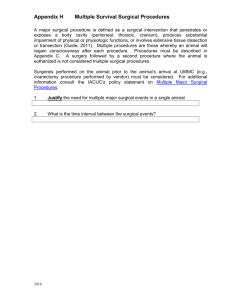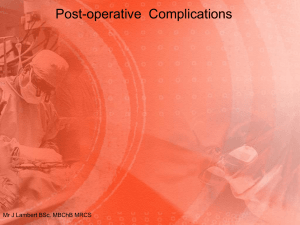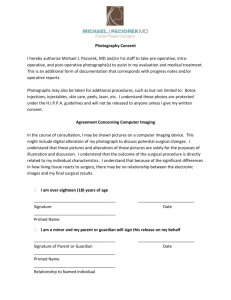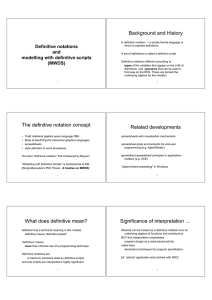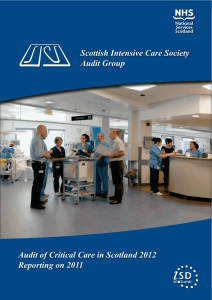A CCrISP APPROACH TO THE DETERIORATING PATIENT
advertisement
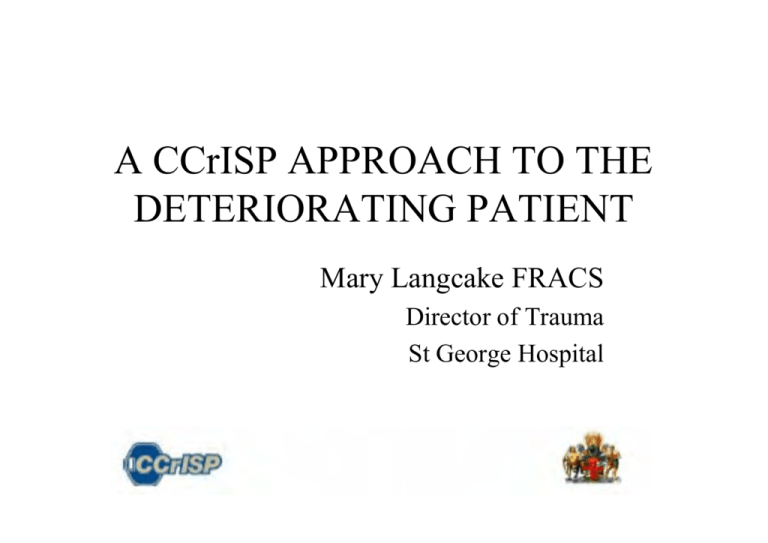
A CCrISP APPROACH TO THE DETERIORATING PATIENT Mary Langcake FRACS Director of Trauma St George Hospital CCrISP • Care of the Critically Ill Surgical Patient • Developed in UK after Hillsborough Soccer disaster • RACS administers under MOU WHY • We perform complex procedures on older sicker patients • JMO’s need to deal with sick and often unfamiliar patients WHAT • Teaches: “Prompt, simple actions save lives AND prevent complications” WHO FACULTY • Multidisciplinary – surgeons, intensivists, emergency physicians, anaesthetists • Must undertake CCrISP Instructors Course or similar – Educator and fellow Instructors teach • Performance assessed by candidates and feedback given to facilitate ongoing development as an educator with support from Committee as required • Nurse co-ordinator – ED or ICU trained • Nurse observers – assist with scenarios, proselytise about CCrISP WHO CANDIDATES • Pre 2008 - surgical trainees – 90% • From 2008 – surgical trainees - 20% – Australia, New Zealand, Fiji, PNG HOW? • • • • • • • Lectures Demonstrations Small group tutorials MCQs Role-playing with moulaged patients All candidates assigned a mentor - guidance/feedback Summative assessment Objectives Recognise the patient who needs simultaneous assessment and resuscitation Employ a system of assessment – to prioritise and to prevent omissions Be able to institute both immediate life‐saving measures and definitive management for the critically ill patient Formulate daily management plans for surgical patients Patients to be considered Routine pre‐operative patients Risk factors – identify and control or improve Emergency Admissions Severe acute problems Co‐morbidity Ward/HDU patients Sudden deterioration Failing to progress/‘not right’ At risk from surgery or disease processes Immediate Management A B C D E Full Patient Assessment Chart Review History and Systematic Exam Available results Decide and Plan Stable Patient Unstable/Unsure Diagnosis Required Daily Management Plan Specific Investigations Definitive Treatment Medical Surgical Radiological Immediate management Diagnose, Prioritise and TREAT immediate threats to life Airway Breathing Circulation Disability/Dysfunction of CNS Exposure End of Immediate Management Immediate steps undertaken to preserve life Ongoing monitoring established Stable/improving vital signs? Called for help Moved to theatre or HDU/ICU Not the end , just the beginning! Now ..find the real source of the problem! If at any time the patient’s condition deteriorates You must go back to the start and Re-assess ABCDE Immediate Management A B C D E Full Patient Assessment Chart Review History and Systematic Exam Available results Decide and Plan Stable Patient Unstable/Unsure Diagnosis Required Daily Management Plan Specific Investigations Definitive Treatment Medical Surgical Radiological Communication Ensure the patient is well‐informed Case note entry Inform others Record plan against which you can check progress Helps you organise your thoughts Pre‐ weekend summaries are very helpful Nursing staff Parameters, plan Senior and other colleagues Relatives SUMMARY Understand need for simultaneous assessment and resuscitation System of assessment reduces serious omissions Institute a plan for definitive treatment Reach a diagnosis to account for deterioration SUMMARY Safe and selective investigations Frequent clinical re‐assessment Inform and involve your seniors appropriately Consider level of care necessary at each stage CURRICULUM REVIEW • CCrISP Committee in final stages of review with plans to pilot the Australasian 3rd edition early 2010 • Aims to keep the Course relevant and fresh


